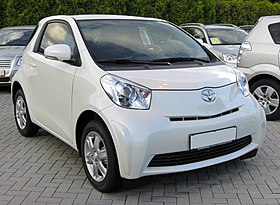Toyota iQ
| Toyota iQ | |
|---|---|
 |
|
| Overview | |
| Manufacturer | Toyota |
| Also called | Scion iQ Aston Martin Cygnet |
| Production | 2008–March 2016 |
| Assembly | Japan: Toyota, Aichi (Takaoka plant) |
| Designer |
Toyota ED2 Hiroki Nakajima (2006) |
| Body and chassis | |
| Class | City car |
| Body style | 3-door hatchback |
| Layout | FF layout |
| Related | Aston Martin Cygnet |
| Powertrain | |
| Engine | 1.0 L I3 1.3 L petrol I4 1.4 L diesel I4 |
| Transmission | 5-speed manual, 6-speed manual, CVT Aisin K41 |
| Dimensions | |
| Wheelbase | 2,000 mm (78.7 in) |
| Length | Toyota iQ: 2,985 mm (117.5 in) Scion iQ: 3,051 mm (120.1 in) |
| Width | 1,680 mm (66.1 in) |
| Height | 1,500 mm (59.1 in) |
| Curb weight | 860 kg (1,896 lb) |
The Toyota iQ was a transverse engined, front-wheel-drive city car manufactured by Toyota and marketed in a single generation for Japan (2008–2016), Europe (2008–2015), and North America (2012–2015) where it was marketed as the Scion iQ. A rebadged variant was marketed in Europe as the Aston Martin Cygnet (2009–2013).
Designed at the Toyota European Design and Development studio in Nice, France, the iQ is noted for its specialized engineering to maximize passenger space, while minimizing exterior length. The design accommodates three passengers—and provisionally a fourth, under very tight conditions.
Following a concept presention at the 2007 Frankfurt Auto Show, the production iQ debuted at the March 2008 Geneva Auto Show. Japanese sales began in November 2008 and European sales in January 2009.
In 2008, the iQ was named the Japanese Car of the Year. The name iQ, an initialism of the term intelligence quotient, recalls a competitor, the Smart Fortwo. The letters "iQ" also stand for "individuality", "innovation", "quality", a hint at its "cubic form" and also a "cue" for owners to embrace new types of vehicles and lifestyles.
The iQ reached the end of production in December 2015, and it was discontinued in Japan in March 2016.
The IQ design emphasizes low fuel consumption, maneuverability, environmental friendliness, and maximized interior space. Six specific design factors contribute to IQ's minimal overhangs, forward windscreen location, maximized cabin space and overall compactness:
The iQ features a transmissions differential housing located ahead of, rather than behind, the engine; a starter motor incorporated in the engine's flywheel, a high-mounted steering rack and a compact, high-located air conditioning unit behind the dashboard central area. The arrangement allows the front passenger to sit forward of the driver, giving increased rear passenger legroom. A shallow under-floor fuel tank reduces rear overhang.
...
Wikipedia
